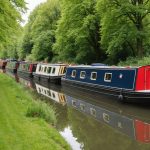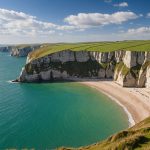Overview of the UK’s Historic Canals
The historic canals of the UK are not just marvels of engineering, but they also whisper stories of eras gone by. Rooted deep in canal history, these UK waterways once served as the lifeline of trade during the Industrial Revolution. Historic canals such as the Grand Union and Regent’s Canal interlace Britain’s landscapes, stretching over 2,000 miles. These networks were constructed primarily in the 18th and 19th centuries, designed with locks, aqueducts, and tunnels that exhibit remarkable engineering prowess.
The contribution of these canals in shaping the trade and transportation system of their time cannot be overstated. They were instrumental in transporting coal, iron, and other goods, drastically reducing the cost and time associated with road transport. As you explore these water routes, envision horse-drawn barges once cutting through the waters, creating bustling trade routes pivotal to the UK’s economy.
In parallel : Immerse Yourself in the UK’s Ultimate Victorian Christmas Market Adventure
Though trains and trucks have long overtaken these waterways, the charm and historical significance of the UK’s canals linger, offering a window into a transformative period of British industrial heritage.
Hidden Gems Along the Canals
Exploring the UK’s picturesque canals reveals numerous hidden gems waiting to be discovered. These scenic spots, tucked away from bustling main routes, offer a tranquil escape into nature and history. For instance, the Basingstoke Canal is renowned for its serene waters, rich with kingfishers and lush vegetation.
Also to read : Exploring the Hidden Treasures of the UK’s Medieval Cathedrals: An Enthralling Guide for History Buffs
The Pocklington Canal poses another enchanting adventurer’s playground, known for its peaceful surroundings and diverse wildlife, including otters and rare aquatic plants. Its tranquillity contrasts sharply with the once-bustling trade routes coursed by historic canals. Meanwhile, the Montgomery Canal offers not just scenic beauty but fascinating historical insights, with restored structures exemplifying canal engineering prowess.
The interplay of local flora and fauna enhances the charm of these picturesque canals. Spot kingfishers darting across the water or follow the quiet paddling of swans. Each season paints the canal landscapes differently, offering continuously evolving scenic spots. Whether you are a nature enthusiast or a history buff, these hidden gems along the canals promise rewarding visual experiences and introspections on human endeavours, as shaped by the UK waterways.
Guided Adventures and Tours
Exploring the UK’s waterways through organised canal adventures offers a unique perspective on the nation’s historic canals. Among the available guided tours, there are various options tailored to suit diverse interests. From leisurely boat cruises to immersive walking tours, each promises a distinct experience focused on different aspects of the canals.
These tours provide rich insights into canal history, unveiling stories and hidden details that might be overlooked otherwise. Enthusiasts can join kayaking excursions or history-oriented walks to delve deeper into the canal heritage.
Types of Guided Tours
A variety of tours cater to different exploration styles. Consider a traditional narrowboat cruise for a relaxed scenic spot journey, or opt for cycling tours along the canal towpaths if you’re more active. Walking tours often focus on local culture and historical insights, providing ample opportunities to learn about the surrounding areas.
Recommended Tour Providers
Renowned companies like Canal & River Trust and Drifters offer expertly guided tours. They are known for their knowledgeable guides who recount anecdotes and cultural history at each stop, ensuring an engaging experience full of discoveries about the UK’s waterways.
Local History and Cultural Context
The canal heritage of the UK is deeply intertwined with the nation’s local culture and historical insights, offering a vivid reflection of the past. Specific canals are tied to significant historical events. For instance, the Leeds and Liverpool Canal played a crucial role in the Industrial Revolution by connecting the woolen centres in Yorkshire to the port in Liverpool. This infrastructure boost significantly bolstered local economies and trade activities.
Canals also hold cultural significance in local communities. They served as communal hubs where workers congregated, fostering a unique social fabric. These waterways are the veins through which stories of local industry and life flowed, encapsulating both hardship and community spirit.
Numerous noteworthy landmarks pepper the canalside landscapes. Take, for instance, the Anderton Boat Lift near the Weaver Navigation—a feat of Victorian engineering marvel that speaks volumes of the historical ingenuity. Amidst these winding paths, tales of innovation and resilience find their home, enriching the landscape with historical insights into the everyday lives shaped by these UK Waterways. As their waters ripple through the countryside, they preserve memories of a vibrant past within their currents.
Tips for Exploring the Canals
When embarking on an adventure through the UK waterways, be prepared to engage in various activities beyond guided tours. Practical exploration tips enhance your journey, ensuring a seamless and enjoyable experience. Start with understanding the travel advice to access these pathways effectively. Maps and local guides can be invaluable in navigating the many winding routes and locks.
Safety considerations are crucial. Carry a life jacket if participating in water-based activities such as kayaking or boating. The weather can be unpredictable, so dress appropriately and carry essentials like water and snacks for longer excursions.
For those inclined towards canal activities, cycling along towpaths or engaging in wildlife photography offer enriching experiences. Keen birdwatchers will find reward in observing local fauna like swans and kingfishers. Along the banks, quaint villages and canal-side pubs provide charming stops.
Immerse yourself in the rich history and vibrant ecosystem of the canals. By following these best practices, your exploration becomes both a fulfilling and safe venture through the picturesque and culturally significant landscapes of the UK’s historic canals.
Engaging Visuals: What to Expect
Exploring the UK’s historic canals is a journey rich with visual experiences, capturing moments of serene beauty and stunning landscapes. These UK waterways offer an exceptional backdrop for scenic photography, where enthusiasts can capture the picturesque canals in their full glory.
Capturing the Essence of the Canals
To encapsulate the magic of the canals, focus on diverse elements such as sunlight glinting off the water or the intricate details of canal locks and bridges. The interplay of light and shadow can transform the most mundane scenes into captivating visual experiences.
Must-Visit Sights for Photography
For breathtaking shots, visit renowned spots like the Grand Union Canal with its sweeping views or Regent’s Canal for urban charm. Each location provides unique perspectives on the UK waterways, perfect for any photographer’s portfolio.
Seasonal Highlights and Best Times to Visit
Maximise your scenic photography by strategically planning seasonal visits. Spring and autumn offer vibrant colours and dynamic lighting, enhancing the canal views. These seasons are ideal for capturing the historic canals amid natural beauty. Whether a casual observer or a seasoned photographer, these canals are treasure troves of visual wonders waiting to be discovered.









